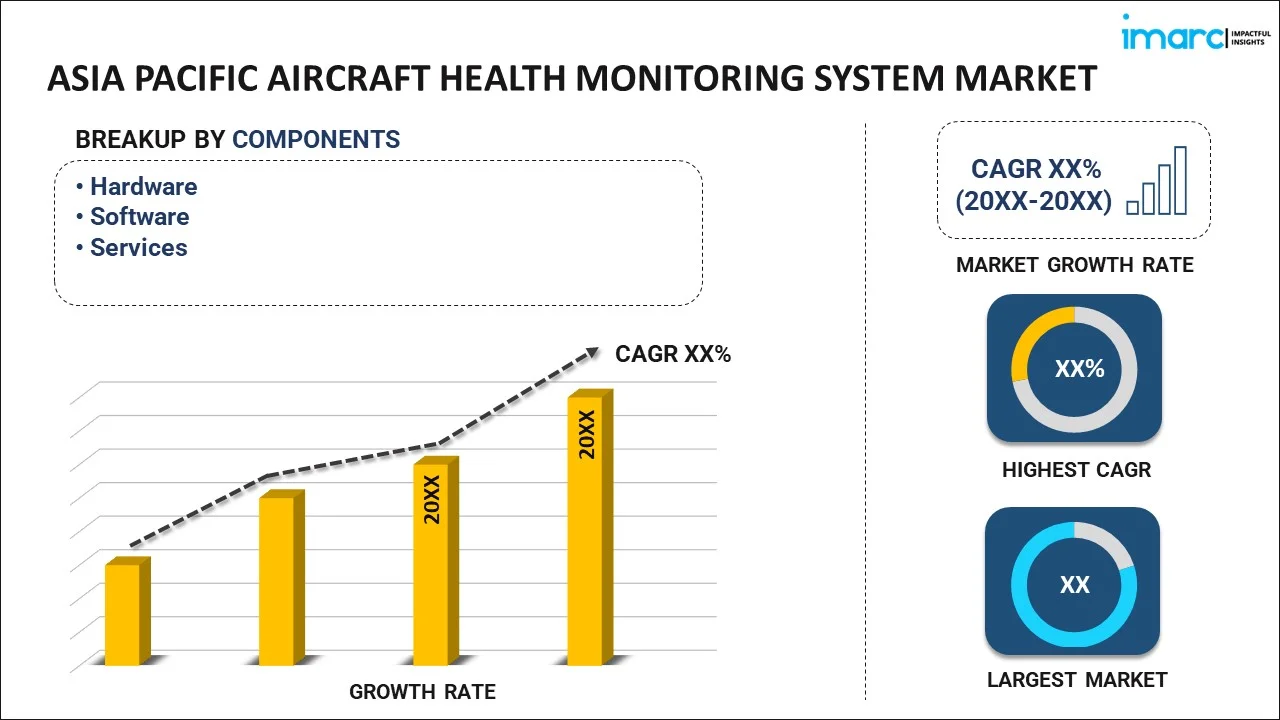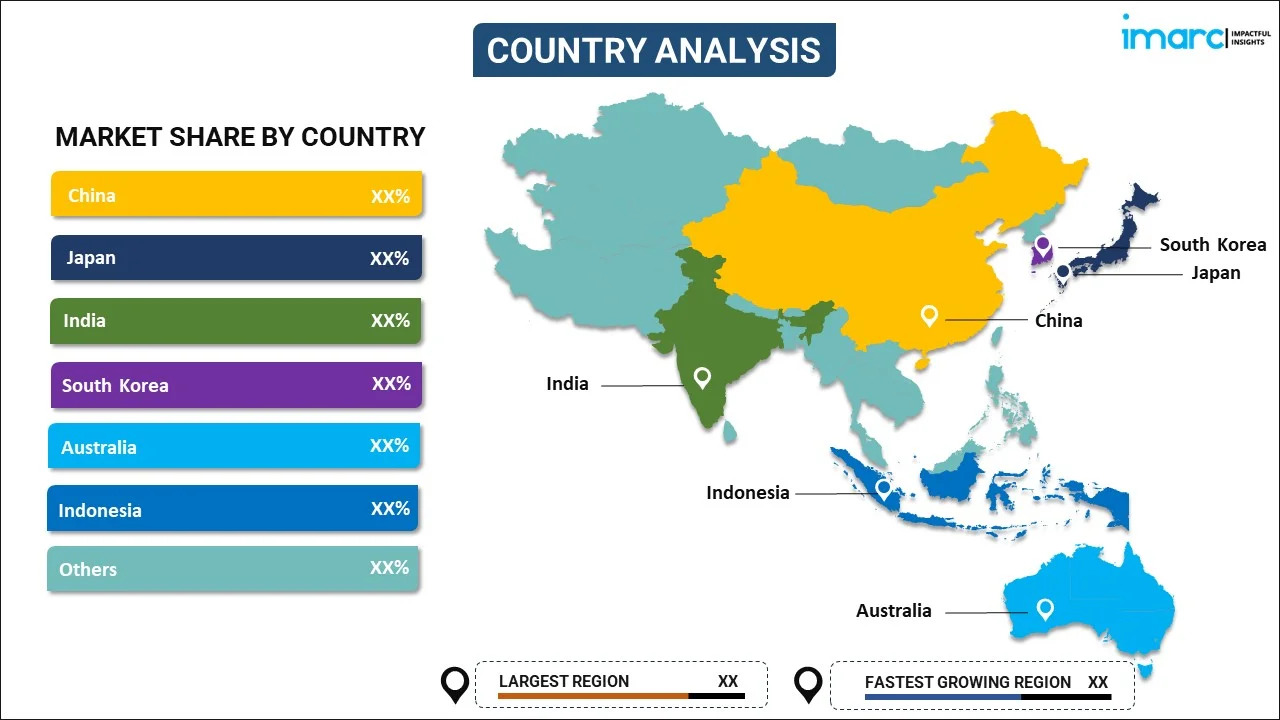
Asia Pacific Aircraft Health Monitoring System Market Report by Component (Hardware, Software, Services), Subsystem (Aero-Propulsion, Avionics, Ancillary Systems, Aircraft Structures, and Others), End User (Commercial, Military), Installation (Onboard, On Ground), Fit (Linefit, Retrofit), Operation Time (Real-Time, Non-Real-Time), Operation Type (Detection, Diagnostics, Condition-Based Maintenance and Adaptive Control, and Others), and Country 2025-2033
Market Overview:
The Asia Pacific aircraft health monitoring system market size reached USD 1.44 Billion in 2024. Looking forward, IMARC Group expects the market to reach USD 2.54 Billion by 2033, exhibiting a growth rate (CAGR) of 6.14% during 2025-2033.
|
Report Attribute
|
Key Statistics
|
|---|---|
|
Base Year
|
2024
|
|
Forecast Years
|
2025-2033
|
|
Historical Years
|
2019-2024
|
|
Market Size in 2024
|
USD 1.44 Billion |
|
Market Forecast in 2033
|
USD 2.54 Billion |
| Market Growth Rate 2025-2033 | 6.14% |
Aircraft health monitoring system (AHMS) refers to a real-time tool that is used to monitor and enhance flight safety and reduce operational time and maintenance costs. It functions by recording actions, performances, and status of aircraft components into a remote database. The collected data is then shared with ground operations through sensors installed at various damage hotspot locations throughout the aircraft structure or engine. AHMS technology is usually deployed in airlines and the aviation industry to foresee unexpected events and as a preventive measure to reduce the chances of unscheduled maintenance and disruption in operations.
The Asia Pacific aircraft health monitoring system market is primarily driven by the increasing usage of electronics in airplanes, especially with the introduction of a new field called avionics. Besides this, the growing number of aging aircraft and the rising commercial air traffic are also catalyzing the market growth. With the spread of coronavirus disease (COVID-19), the aviation industry is trying to minimize costs by deploying AHMS, which helps increase the profitability by improving safety and making flight operations more effective. Furthermore, the demand for AHMS is rising due to the growing utilization of database-related IT solutions and analytics products in countries across the region.
Key Market Segmentation:
IMARC Group provides an analysis of the key trends in each sub-segment of the Asia Pacific aircraft health monitoring system market report, along with forecasts at the regional and country level from 2025-2033. Our report has categorized the market based on component, subsystem, end user, installation, fit, operation time and operation type.
Breakup by Component:

- Hardware
- Software
- Services
Breakup by Subsystem:
- Aero-Propulsion
- Avionics
- Ancillary Systems
- Aircraft Structures
- Others
Breakup by End User:
- Commercial
- Military
Breakup by Installation:
- Onboard
- On Ground
Breakup by Fit:
- Linefit
- Retrofit
Breakup by Operation Time:
- Real-Time
- Non-Real-Time
Breakup by Operation Type:
- Detection
- Diagnostics
- Condition-Based Maintenance and Adaptive Control
- Others
Breakup by Country:

- China
- Japan
- India
- South Korea
- Australia
- Indonesia
- Others
Competitive Landscape:
The competitive landscape of the industry has also been examined along with the profiles of the key players.
Report Coverage:
| Report Features | Details |
|---|---|
| Base Year of the Analysis | 2024 |
| Historical Period | 2019-2024 |
| Forecast Period | 2025-2033 |
| Units | Billion USD |
| Segment Coverage | Component, Subsystem, End User, Installation, Fit, Operation Time, Operation Type, Country |
| Countries Covered | China, India, South Korea, Japan, Australia, Indonesia, Others |
| Customization Scope | 10% Free Customization |
| Post-Sale Analyst Support | 10-12 Weeks |
| Delivery Format | PDF and Excel through Email (We can also provide the editable version of the report in PPT/Word format on special request) |
Key Questions Answered in This Report
The Asia Pacific aircraft health monitoring system market was valued at USD 1.44 Billion in 2024.
We expect the Asia Pacific aircraft health monitoring system market to exhibit a CAGR of 6.14% during 2025-2033.
The increasing utilization of aircraft health monitoring systems for monitoring the lifecycle of aircraft components and predicting failures or malfunctions, such as over-heating of engines, high vibrations, low oil pressure, etc., is primarily driving the Asia Pacific aircraft health monitoring system market.
The sudden outbreak of the COVID-19 pandemic had led to the implementation of stringent lockdown regulations across several Asia Pacific nations, resulting in the decline of various aviation activities, thereby negatively impacting the Asia Pacific market for aircraft health monitoring systems.
Based on the component, the Asia Pacific aircraft health monitoring system market can be bifurcated into hardware, software, and services. Currently, hardware exhibits a clear dominance in the market.
Based on the subsystem, the Asia Pacific aircraft health monitoring system market has been categorized into aero-propulsion, avionics, ancillary systems, aircraft structures, and others. Among these, aero-propulsion currently accounts for the majority of the total market share.
Based on the end user, the Asia Pacific aircraft health monitoring system market can be segmented into commercial and military. Currently, commercial holds the largest market share.
Based on the installation, the Asia Pacific aircraft health monitoring system market has been divided into onboard and on ground, where onboard currently exhibits a clear dominance in the market.
Based on the fit, the Asia Pacific aircraft health monitoring system market can be categorized into linefit and retrofit. Currently, linefit accounts for the majority of the Asia Pacific market share.
Based on the operation time, the Asia Pacific aircraft health monitoring system market has been segregated into real-time and non-real-time, where non-real-time currently exhibits a clear dominance in the market.
Based on the operation type, the Asia Pacific aircraft health monitoring system market can be bifurcated into detection, diagnostics, condition-based maintenance and adaptive control, and others. Currently, detection holds the largest market share.
On a regional level, the market has been classified into China, Japan, India, South Korea, Australia, Indonesia, and others, where China currently dominates the Asia Pacific aircraft health monitoring system market.
Need more help?
- Speak to our experienced analysts for insights on the current market scenarios.
- Include additional segments and countries to customize the report as per your requirement.
- Gain an unparalleled competitive advantage in your domain by understanding how to utilize the report and positively impacting your operations and revenue.
- For further assistance, please connect with our analysts.
 Inquire Before Buying
Inquire Before Buying
 Speak to an Analyst
Speak to an Analyst
 Request Brochure
Request Brochure
 Request Customization
Request Customization




.webp)




.webp)












